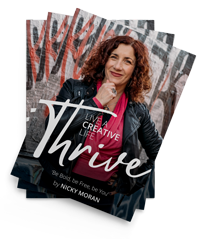
I absolutely hate to plan, but I know that, without any plan, my life is in chaos, I procrastinate and I am not productive. So, a bit of forward-thinking can save huge amounts of time and can lead to a more successful and peaceful way of living.
So why do I resist it?
Well – mainly because when I’m in a state of creative excitement or enthusiasm, I tend to dive straight into doing stuff. I go from idea to idea, finding all sorts of cool and interesting things that make me fizzle with enthusiasm. And, before you know it, I’m in chaos. I’ve completely lost sight of what I was trying to achieve in the first place!
But one simple idea changed my life and my thinking. It was put forward by a controversial Italian economist called Vilfredo Pareto. He called it the 80/20 principle. He discovered that 80% of wealth resides with 20% of people. He also discovered that this ratio applies to most things in life, including the way you spend your time. Therefore, in time-management terms, 80% of your productivity comes from 20% of your efforts.
So – here is my SIMPLE strategy for planning a project that takes minutes, but saves masses of time and effort in the long run.
How it works:
You start the process by thinking about your end result and then work backwards – SIMPLE!
If you work best by writing down your ideas , it’s great, because it’s physical, too, which helps you to solidify your thoughts.
Ten Steps to a Well Planned Project
You will need some Post-it notes, a notepad and a pen. Use one Post-it note for each step, so you can move them around as you think through the details.
1. Imagine that your project has been a huge success. Close your eyes and visualise or imagine what would be happening. Take time to notice what you see and hear or who is involved. Indulge in this picture for a while – have fun and enjoy any feelings that come up for you.
2. When you open your eyes, write down anything that you remember of the imagined scene in as much detail as possible.
3. Now write down a more specific outcome that you want to achieve. Write it as a SMART objective – i.e. Specific, Measurable, Achievable, Realistic and Time-bound, eg. “I want to sell 1,000 books by June 2013” or “I want to be interviewed on Woman’s Hour by December 2012”.
4. Next, on separate Post-it notes, write down any actions, in any order, that you need to take along the way to achieve this outcome.
5. And now, similarly, write down any skills that you need in order to achieve the outcome.
6. Write down the milestones that you will need to reach along the way in order to achieve the main outcome.
7. Reviewing these action steps, ask yourself whether you could delegate some of them, and, if so,, who to.
8. Move the Post-it notes around into a logical sequence that will work towards achieving your desired outcome, ie a successful project. Add any additional steps that come to mind.
9. On each Post-it note, write a rough date by which each needs to be done.
10. Transfer your notes onto a simple project plan with a time line. See the example below.
Project outcome:
To complete a book and sell 1000 copies by June 2013
| Timeline2011-June 2013 | February 2011 | March 2011 | April 2011 |
| Write a book summary | Write three chapters | Write three chapters | |
| Research rival books | Contact three magazines | Contact radio editors | |
| Buy writer’s handbook | Send out newsletter | ||
| Research and write list of editors | Send brief to ten publishers | ||





3 responses
greetings, really good weblog, and a really good understand! at least one for my book marks.
Thanks Brenda – let me know how you get on! Nicky x
I’ve already told you I think you’re a genious, but I’ll say it again: You are a genious! I have firmly decided to follow you every suggestion. Now I just have to pick one of my big old pile of ideas and get started…